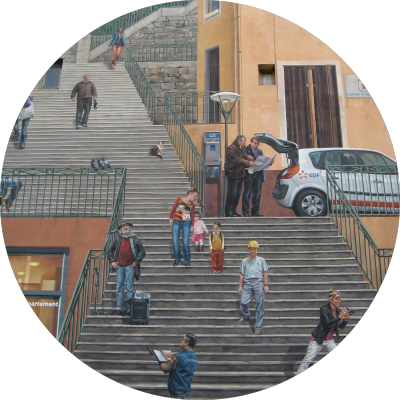Lyon off the beaten track: exploring Croix-Rousse
 What’s in the anagram OnlyLyon? What publicist thought up this brilliant marketing strategy to promote France’s second largest metropolitan area and third largest city?
What’s in the anagram OnlyLyon? What publicist thought up this brilliant marketing strategy to promote France’s second largest metropolitan area and third largest city?
Lyon is a singular place: I have never needed any persuading to travel to this Unesco World Heritage site.
I love its dramatic position between the Rhône and the Saône, rolling up and down the hills; its impressive Roman forum and exceptional museums. And of course who can forget its gastronomy – not just restaurants but the beautiful Saint-Antoine market with over 100 vendors.
For practical information and travel tips on Lyon, see two recent articles in MyFrenchLife™: savvy traveler tips and a city guide to Lyon.
But let me tell you about a part of town that has always eluded me: le Quartier de la Croix-Rousse. It’s named for the russet-colored stone cross that was placed here in the 16th century. A few months ago, I made a point to spend several days in the neighborhood.
A hillside of history
Away from the center of the city, built along a hillside that culminates in a wide plateau, the Croix-Rousse was once the center of Lyon’s prosperous silk industry. In fact the quartier was dubbed ‘la colline qui travaille‘, the hill that works, while Fourvière, the neighboring hilltop was ‘la colline qui prie‘, the one that prays. That’s where you will find Lyon’s majestic basilica.
Although the silk industry existed across the region for hundreds of years, it was established in the Croix-Rousse in the 1800s. A stroll around the area gives a good idea of how extensive the workshops were. Noteworthy are some of their characteristically large windows, designed to let in light and air.
To learn about the silk industry, stop by the Maison des Canuts. The museum features exhibits on various techniques used in textile production, such as the Jacquard loom, invented in 1801. There are descriptions too, of the life of silk workers or canuts. There were over 200 000 by the end of the 19th century. Some of France’s earliest workers’ strikes for better pay began here, in the 1830s.
Today, the silk tradition continues in the area’s textile schools and contemporary silk factories. The week-long Festival Label Soie is held in autumn, with tours and conferences.
Walls and secret walks
Lyon is well known for its painted murals. One not to miss is the Croix-Rousse’s Mur des Canuts, the largest in Europe. In the 1980s it was a blank wall and deemed an eyesore. Recently renovated, it offers a vivid portrait of the neighborhood and its inhabitants. It’s common to see tourists pose in front of the mural, joining in its amusing trompe-l’oeil scenes.
And one more thing: the Croix-Rousse is the place to explore Lyon’s traboules. For centuries, these unusual passageways have connected streets and buildings through a network of inner courtyards and stairs. During the Nazi occupation, members of the Resistance used the shortcuts for quick getaways.
What secret hideaways in France are among your favorites? Tell us below!
All images © Ronnie Hess.
This popular article was refreshed and republished in 2021.









